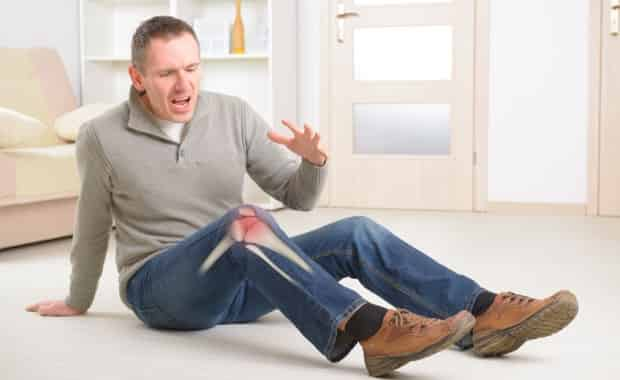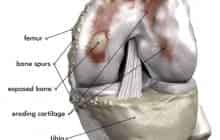
Many knee problems occur during sports or recreational activities, work-related tasks, or home projects. Knee problems may also manifest due to injury, disease, overuse, or just everyday wear and tear. The complex design of the knee and the fact that it is one of the primary weight-bearing joints in your body are reasons why knee problems develop and why it is one of the most commonly injured joints.1
Arthritis of the knee
Although there are many types of arthritis that have potential to affect your knees in some way, by far the most common are osteoarthritis and rheumatoid arthritis – both of which are treatable.
- Osteoarthritis is a disease that gradually causes the cushioning cartilage within your knee to wear away resulting in pain when bone rubs against adjacent bone. It is most often associated with aging and usually begins in those over 50 years of age although it is not unknown in much younger persons. Osteoarthritis may also be the long term outcome of a previous serious injury.
- Rheumatoid arthritis usually affects younger people and is an auto-immune disease, which means one’s immune system attacks certain tissues in the body. In this case, it attacks the membrane (synovium) that lines the knee joint, but may also destroy cartilage, bone and sometimes muscles, tendons and ligaments too.2
- Other common forms of arthritis of the knee include gout (uric acid waste crystals in the joints), lupus (another autoimmune disease), psoriatic arthritis (inflamed joints as a precursor to psoriasis), and infectious arthritis (brought on by infectious agents such as bacteria or viruses).
Treatment of arthritis in your knee is determined by the type and severity of arthritis. In the early stages of osteoarthritis, you may find relief from pain through over-the-counter pain relievers and lifestyle modifications like weight loss and performing mild exercises that strengthen the muscles that support the knee.2
If osteoarthritis has progressed and relief from pain is more difficult to achieve and your lifestyle has become severely compromised, a knee resurfacing or total knee replacement may be the solution to ending the pain.
People with other types of arthritic disease of the knee such as rheumatoid arthritis and lupus often require drugs that are developed to control the underlying disease that is the root cause of their knee problems.2 These types of drugs are usually prescribed after less powerful drug alternatives are no longer effective.
Injury to ligaments
We usually associate injury to the knee with torn or strained ligaments. Since the knee is the largest and most complex joint in the body, it follows that the variety of ligaments and muscles surrounding it are considerable. The most common structures to be injured or damaged are the cartilages within the joint and the two cruciate ligaments which keep the two bones of the knee (femur and tibia) together and functioning properly.
The onset of pain after injury to one or more of the ligaments is either immediate and made worse with movement or can build up over a period of time with prolonged abuse. Additionally, injury to either of the cruciate ligaments can be accompanied by a “popping” sensation deep within the knee. This type of injury is invariably associated with extreme sports such as soccer, football and rugby.
Initial treatment for sprained ligaments consists of applying ice packs, elevating the knee, and immobilization. More severe injuries may require surgical repair or grafting either by open knee surgery or arthroscopic surgery. Current surgical reconstruction procedures to the ligaments of the knee are experiencing increasingly successful results.1
Pain in the knee ligaments
Tendinitis is the term for inflammation of any tendon or ligament. The inflammation is usually brought on by any repetitive activity that strains the tendon. Fairly common, tendinitis of the front patellar tendon is known as “jumpers knee” because in sports that require jumping, such as basketball, the muscle contraction and force of hitting the ground after a jump strain the tendon. After repeated stress, the tendon may become inflamed or even tear.2 Diagnosis is based upon localizing pain and tenderness to either of these tendons.
Treatment consists of a combination of ice pack application, immobilization, rest and taking simple pain medications such as acetaminophen (Tylenol). If the pain is significant, prescription medications may be appropriate. While rest is the most important factor in healing tendinitis, gentle stretches and exercise will help to encourage the tendons into normal activity again. In severe cases, such as a ruptured (torn) tendon, there may be bleeding within the knee accompanied by severe pain with knee movement of any kind. These cases invariably require surgical repair.1
Injury to the meniscus
The meniscus is a thick pad of cartilage that acts as a smooth cushion and rim between the femur (thigh bone) and the tibia (shin bone) facilitating natural movement between these two bones. The menisci can be injured by rotating the knee while bearing weight such as when a person quickly twists, rotates or angulates at the knee joint. Some tears can be repaired while others require a trimming of the damaged portion. The seriousness of a tear depends on its location and extent of the tear.2 This type of injury is often experienced by participants in sports that require fast reaction body movements such as required in basketball and tennis but can in fact be sustained by almost anybody in relatively minor incidents such as a trip or a fall or even as part of the arthritic process.1
When the meniscus is injured some pain will generally be experienced, especially when the knee is fully straightened and on weight bearing. There may also be some swelling as such injuries can cause excess fluid to build up within the joint, or the surrounding tissues can become swollen if there was a significant injury. Symptoms of meniscal injury may sometimes disappear on their own, but frequently persist or return months or years later and require treatment, particularly if the knee is injured a second time.2 Meniscal tears are usually repaired via arthroscopy.
Summary
Knee problems can be caused by many factors such as injury, arthritis, disease, aging, and being overweight. Although knee problems as a result of an accident cannot be avoided, other knee problems can be lessened or avoided by:
- Warming up your muscles before sports by walking and stretching.
- Avoiding sudden changes in the level of exertion in exercises and activities you’re currently enjoying.
- Wearing shoes that fit correctly and are in good condition.
- Strengthening your leg muscles through exercise such as walking up stairs or working out with weights.
- And finally…maintaining a healthy weight as extra weight puts additional pressure on your knees.3
Sources
- WebMD, “Knee Injuries and Osteoarthritis” http://www.webmd.com/osteoarthritis/guide/osteoarthritis-knee-injuries
- National Institute Health Arthritis, Musculoskeletal and Skin Diseases, “Questions and Answers about Knee Problems” http://www.niams.nih.gov/Health_Info/Knee_problems/
- National Institute Health Arthritis, Musculoskeletal and Skin Diseases, “What Are Knee Problems? Fast Facts” http://www.niams.nih.gov/Health_Info/Knee_Problems/knee_problems_ff.asp
Filed Under: Knee ReplacementThe Knee Joint






